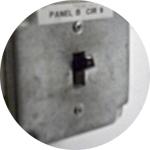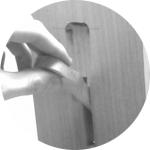

As methods of controlling machines or processes, switches are a common method of interacting with the technology that affects our everyday life. The response offered by the switch affects the experience of switching. In the electronic realm, the switch is a bit--a simple unit of information with the value 0 or 1 (true or false). But in the broader sense, the term refers to any mechanism used to shift, transfer, divert, connect or disconnect. While technically fairly simple, switches are in the cultural and social sense a more complex phenomena. Electronic devices easily receive and process information regarding "on" and "off" (True or False). But conceptually a switch refers to any control that users have over an aspect of operation or process. As users of technology we often use switches as our interface with technology. How the switches are presented (how they look and feel) is an important factor in our experience. Here we explore the act of switching along with the switch itself.

Many technologies give us information, while others take information as input--most do some of both. The switch is an integral part of inputting information in order to control the technology or machine. Why would we want to have some sort of control over environment or processes? These machines provide us the elements that dictate our life experience. Light, water, information--all are commodities for which a switch often dictates an "on" or an "off" parameter. On the other hand, many switches demonstrate that more complexities are available.
In our effort to explore the act of switching, we have designed two switches--the wood switch and the velvet switch. These have been excercises in design that have encouraged us to focus on the switching mechanism and the act of operating. By divorcing the mechanism from any apparent function, we have been able to dedicate our explorations solely on visual and tactile experiences that accompany the act of moving a switch. While these two switches have the same function (no function) the experience when operating them is very different.
In this project we have attempted to focus not only on the switch itself, but on the act or process of operating a switching device--and along with it the resulting shift or exchange achieved by such an act. We hope that as we (and others) continue to design new technologies that we all will pay particular attention to elements of design that, while not directly linked to function, affect the experience of using the technology.
Because they are mechanisms that are culturally and socially interesting, a more in-depth understanding of their role could help us design and use new technology in new ways. As an alternate version of a switch, we hope that these series of explorations will cause a switch in the way we design and use technology.